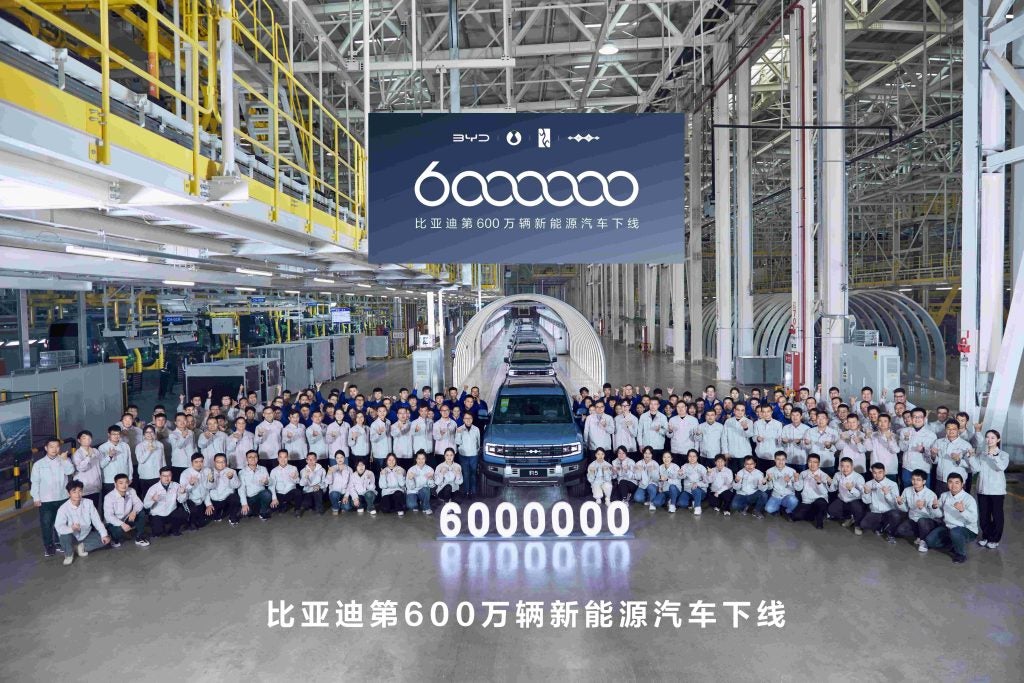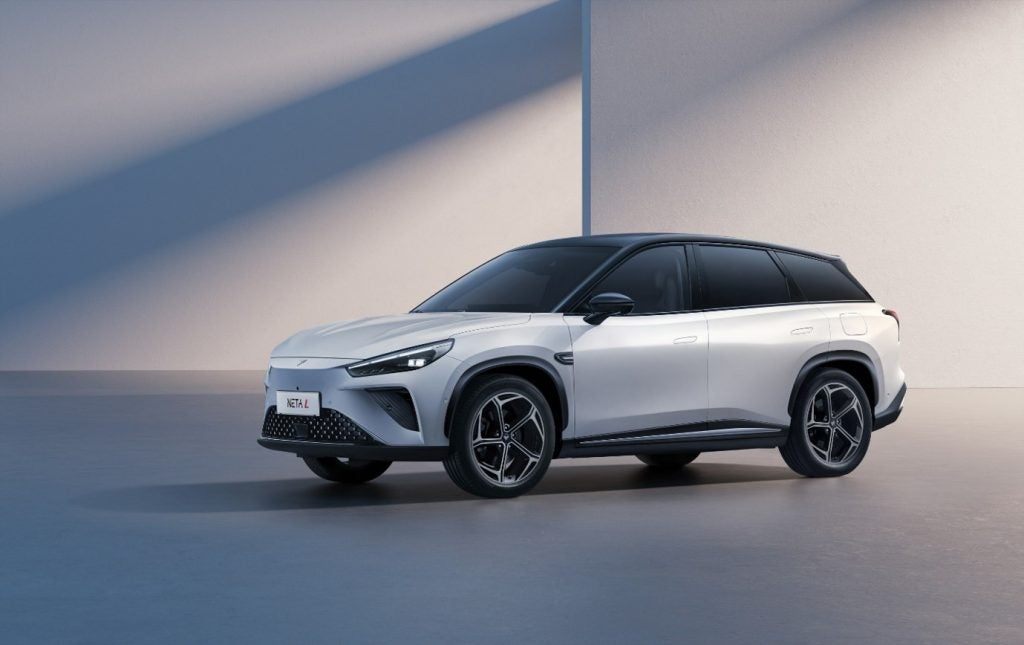 After years of high expectations and low growth, China’s auto market has suddenly taken off.The first three quarters of 2002 saw 2.4 million vehicles sold, up 34 percent from the year before, while passenger car sales soared an astonishing 47 percent to 800,000.The boom has created the belief that China will become the main driver of the otherwise stagnant global auto market over the coming two decades. A flurry of new deals ensures that car-making capacity will rise sharply in the next few years:Toyota, Hyundai and Nissan have each committed over US$1bn to new joint ventures which together will pump out 1.5 million passenger cars annually by 2010.
After years of high expectations and low growth, China’s auto market has suddenly taken off.The first three quarters of 2002 saw 2.4 million vehicles sold, up 34 percent from the year before, while passenger car sales soared an astonishing 47 percent to 800,000.The boom has created the belief that China will become the main driver of the otherwise stagnant global auto market over the coming two decades. A flurry of new deals ensures that car-making capacity will rise sharply in the next few years:Toyota, Hyundai and Nissan have each committed over US$1bn to new joint ventures which together will pump out 1.5 million passenger cars annually by 2010.
China now really does have a sizable individual car market capable of sustained growth. But structural growth is well below this year’s outlandish number, which is boosted by a number of one-offs. More important, it remains questionable how profitable China will ever be for most foreign carmakers, given that the greatest growth will come at the low end of the market and there will be relentless downward price pressure. The ability of foreign companies to fend off domestic competition is also open to doubt. In sector after sector, from white goods to personal computers to telecoms switching equipment, foreign manufacturers have piled into China only to see their technology copied and their prices undercut with alarming speed by domestic competitors operating with government support.The auto companies need to ask themselves why the car market will be any different.
Why the auto boom?
While auto executives like to attribute this year’s spike in sales to things like “increased consumer choice” and “China’s WTO entry”, the basic reason is quite simple: price cuts of 20 percent or more, which started at the bottom end of the market and then rippled upward.The cheapest car on the market, the Tianjin Xiali, now costs around Rmb37,000 (US$4,500); it is one of six models selling for under Rmb100,000 (US$12,000). Another half-dozen models, including new entries by market heavyweights Volkswagen and General Motors, sell for under Rmb150,00 (US$18,000).
This released a wave of pent-up demand, aided by four other factors. First, China now has three auto markets that meet ordinary criteria for car-sales takeoff. Greater Beijing, Greater Shanghai, and Guangdong’s Pearl River Delta each has 20 million-30 million inhabitants and per-capita GDP around the US$3,000 mark. An increasing number of residents in these areas own their own homes and have marked down a car for their next big purchase. Many car buyers also put off purchasing in 2001, because they knew that import tariffs would fall on January 1 this year and assumed, rightly, that prices of domestic cars would also fall.
How well do you really know your competitors?
Access the most comprehensive Company Profiles on the market, powered by GlobalData. Save hours of research. Gain competitive edge.

Thank you!
Your download email will arrive shortly
Not ready to buy yet? Download a free sample
We are confident about the unique quality of our Company Profiles. However, we want you to make the most beneficial decision for your business, so we offer a free sample that you can download by submitting the below form
By GlobalDataNext, auto loans finally became accessible to many buyers. Consumer car lending is still small, but it has risen rapidly in the past year because the main lenders have cut out layers of onerous paperwork and trimmed approval times from three weeks down to three days. Some banks in Shenzhen now offer 24-hour approvals. Finally, a host of new models flooded the low end of the market, giving first-time car buyers an attractive array of choices. Sales growth has been fastest for small, cheap cars; mini and subcompact cars account for over 30 percent of sales, up from 20 percent a year ago (see Table 2).Two of these models, the SAIC Chery (Qirui in Chinese) and Geely Merrie, were made by wholly domestic start-ups that relied heavily on parts and technology suspiciously similar to those of established joint-venture models.
Another factor aiding sales of domestically-made vehicles is that the import floodgates did not open as wide as anticipated following China’s WTO entry. As required by its entry agreement, China on January 1 cut tariffs on imported cars with engines under 3 litres from 70 percent to 43.8 percent. And, as permitted by the agreement, it set a value limit of US$8bn on total automotive imports for the year. Had this amount been applied exclusively to automobiles, it would have implied imports of 300,000- 400,000 units. In reality, imports were just 80,000 in the first eight months because Beijing was slow to issue import licences for vehicles, and because much of the import value quota is taken up by spare parts for joint-venture produced cars.
Is growth sustainable?
China’s auto market has almost certainly turned a corner and is likely to post continued solid growth for some years to come. Automotive Resources Asia (ARA), a consultancy, reckons that over the next several years China’s passenger-car market will grow at 10-15 percent a year. Several factors should underpin growth. Most important, downward pressure on prices will be relentless. In 2006, import tariffs will drop to 25 percent, and import quotas will be abolished. Although the government will doubtless come up with ways to keep the import tide down, high-end customers will likely switch to imports, while domestic makers will have to shift down-market to attract more price-conscious buyers.

| Table 1.Vehicle sales in China |
Q1-3 2002 | Q1-3 2001 | Increase, % | |
All vehicles | 2,380,000 | 1,780,100 | 33.7 |
Domestic passenger vehicles | 803,200 | 546,400 | 47.0 |
Imports* | 80,900 | 72,000 | 12.4 |
| *Jan-Aug figures |
| Source: China Association of Automobile Manufacturers |
| Table 2. China’s passenger car market by segment |
Unit sales Jan-Aug | Year-on-year Growth, % | Market Share, % | |
Mini-cars | 82,676 | 73 | 12 |
Subcompacts | 134,002 | 81 | 19 |
Midsize | 318,539 | 37 | 44 |
Full-size | 95,929 | 10 | 13 |
Luxury | 44,565 | 34 | 6 |
SUVs | 12,121 | 63 | 2 |
Total | 716,1012 | 46 | 100 |
Source: Automotive Resources Asia |
| Table 3. Passenger car sales by production sites, Jan-Aug 2002 |
Unit sales | Market share, % | |
Shanghai Volkswagen | 165,171 | 23.1 |
FAW Volkswagen | 131,027 | 18.3 |
Shanghai GM | 69,694 | 9.7 |
Tianjin Automotive | 62,137 | 8.7 |
Dongfeng Citroen | 50,291 | 7.0 |
Guangzhou Honda | 40,113 | 5.6 |
Chang’an Suzuki | 33,695 | 4.7 |
Shanghai Automotive | 31,892 | 4.5 |
MPV | 28,270 | 3.9 |
Zhejiang Geely | 25,669 | 3.6 |
First Auto Works | 20,054 | 2.8 |
Jiangsu Kia | 11,057 | 1.5 |
Others | 80,727 | 11.3 |
| Source: Automotive Resources Asia |
| Table 4. Passenger car sales by parent company, Jan-Aug 2002* |
Unit sales | Market share, % | |
Volkswagen | 296,198 | 41.4 |
SAIC | 266,757 | 37.3 |
First Auto Works** | 213,218 | 29.8 |
General Motors | 69,694 | 9.7 |
Dongfeng | 51,652 | 7.2 |
| *These figures give combined sales for all of a given parent’s ventures, thus double-counting joint ventures and yielding a total above 100 percent. |
| **Includes figures for Tianjin Automotive |
| Source: Automotive Resources Asia, CEQ |
Second, auto loans will spread. ARA estimates that just 12 percent of individual car buyers used car loans this year, compared to 50 percent in Taiwan and 70-80 percent in most developed-country markets. Domestic banks see consumer loans as an easy way to strengthen their tottering balance sheets, and foreign automakers are eager to bring in their finance companies, which generate a large chunk of their profits in home markets. Increased credit will boost the proportion of cars sold to individuals, which ARA’s Yale Zhang says is now about 40 percent, up from close to zero a decade ago. (The rest are bulk purchases by taxi fleets and government offices).This means that China is closer to being a normal car market where economic ups and downs will drive sales, rather than the whims of government policy.
Finally, and this should not be ignored, the government has an overpowering interest in a car industry boom. Rapid growth in cars and related industries is essential to Beijing’s hopes for sustaining annual GDP growth of 7-8 percent as it gradually shuts down old inefficient state run industries. Based on these factors, annual growth of 15 percent a year in passenger car sales seems plausible, meaning that by 2010 Chinese will buy more than three million cars a year (see chart). General Motors, which has placed a big bet on China, is far more optimistic: it expects annual growth of 25 percent, implying annual sales of over six million cars by 2010.
But the key question for GM and its global competitors is not how big the China market will be.The question is rather, how much benefit will the market provide to the staggering array of foreign firms now staking claims in China? The betting here is that two or three foreign companies may do all right; the rest will waste a lot of money. Car makers, of course, hope otherwise.
Three huge deals were signed in the last three months:
- In August, Toyota committed US$1.3bn to a 50-50 joint venture with First Auto Works (FAW). A Tianjin plant will turn out 400,000 vehicles by 2010.
- In September,Hyundai said it would pour US$1.1bn into a 50-50 joint venture with Beijing Automotive Industry Corp. Initially producing Sonata and Elantra sedans, Hyundai hopes to produce 500,000 vehicles a year by 2010 at this plant and expects its Kia affiliate to produce 300,000 a year by the same date.
- In October, Nissan announced plans to invest US$1bn in a 50-50 joint venture with Dongfeng Automotive, producing 900,000 vehicles by 2010, of which 360,000 will be passenger cars.
It’s telecoms all over again
Far more capacity is now being planned than can possibly be absorbed by the market. Based on published capacity forecasts, plus some rather conservative assumptions, CEQ believes that passenger car production capacity will exceed sales by 20 percent in 2010 (see chart). This overcapacity, if constructed, can mean only one thing: vicious price wars. This has happened in virtually every consumer goods market in China, and foreign players who came in with business plans predicated on big market shares and fat margins have been punished. One or two of the new entrants may manage to eke out profits in this maelstrom, but surely not all of them.
Foreign auto makers should also be afraid of domestic competition – very afraid. In industry after industry, Chinese firms have picked up technology much faster and kicked foreign competitors out of the market far faster than anyone predicted.Think of TVs, air-conditioners, microwave ovens, washing machines, refrigerators, personal computers, telecoms switching equipment – all areas once dominated by foreign manufacturers, now dominated by low-cost Chinese producers. Despite the example of telecoms switching, where local companies like Huawei and ZTE reverse-engineered abstruse technology and then used cheap loans and other government support to drive foreign switch companies out of the market, foreign carmakers used to think that cars were simply too complicated to copy effectively. Think again: two of the fastest-selling models in the first half of the year were the SAIC Chery and the Geely Merrie, locally-produced cars based respectively on the VW Jetta and Daihatsu Xiali.
The case of the Chery is particularly instructive. Originally set up by the city of Wuhu in Anhui province, the Chery plant struck clandestine deals with Volkswagen’s suppliers to get original Jetta parts. When the car first hit the market in 2001 it ran afoul of Beijing – not because it was helping Volkswagen’s suppliers to violate their contracts, but because of the state policy of consolidating the auto industry into a few big players.The Ministry of Public Security instructed its local branches not to issue licences for Cherys until Chery had found a big local partner.This it duly did, as Shanghai Automotive Industrial Corp. (SAIC) – Volkswagen’s partner in producing the Jetta – agreed to buy 20 percent of the company. Meanwhile Chery gave the Anhui provincial government a big stake in the firm in exchange for forgiveness of Rmb13bn (US$1.6bn) owed to state banks.
Volkswagen was foaming at the mouth, of course, but there was little it could do. It extracted a pledge from SAIC that the Chery would no longer use original Jetta parts. But a company executive admitted to the Financial Times that this agreement is unenforceable as any dispute would be tried in Anhui, whose courts would be loathe to rule against their own government. In another country,Volkswagen might well have thrown in the towel. But this is China: Volkswagen plans to invest another US$2.4bn over the next five years. It has little choice, since China accounts for nearly 10 percent of its annual car sales, and has higher growth prospects than most other markets.
Grandmaster versus folk-dancer
There is nothing mysterious or secretive about the Chinese government’s interest in ensuring that the chief benefits of a big car market go to domestic producers.The first automotive policy in 1994, set the goal of creating four or five major domestic vehicle manufacturers, of which two or three would produce passenger cars. This was amplified in June 2001 when the State Economic and Trade Commission (SETC) posted an industry strategy document on its website, singling out FAW, SAIC and Dongfeng for access to capital, fast-track approval for joint ventures, and support in building “technical research centres”.
Graeme Maxton, a principal in automotive consultancy Autopolis and a noted pessimist on the prospects of foreign car companies in China, notes that this goal is well on its way to being met. The three companies mentioned in the SETC notice now account for three-quarters of passenger car production in China through their various joint ventures and directly-owned plants. Dongfeng’s new deal with Nissan, and FAW’s with Toyota, will intensify this trend.
Foreigners often assume that joint ventures are essentially controlled by the foreign partner, but the Chinese government views them as pawns in a larger game whose basic rule is that foreign automakers need China more than China needs any one of them: there are a dozen global automakers, but only one China market. “The Chinese are very good at playing off one foreign company against the other, “ notes Mr Maxton. “When VW wouldn’t pass over the most up-to-date technology [to JV partner SAIC], that’s when GM was brought in” to set up another joint venture with SAIC.







